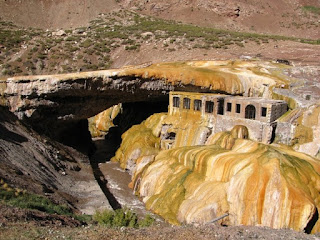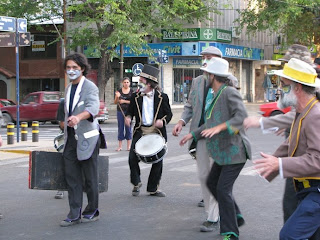I’ve kept you posted on all the highlights of our trip, but I thought you might want to hear more about a routine day. Showers here generally use instant gas hot water heaters. Our shower has pretty low water pressure, but endless amounts of relatively hot water. Since we live in a desert though, I have not made my showers any longer than usual (Mendoza apparently uses more water than any place in Latin America surprisingly). We keep a supply of granola, yogurt, milk and bananas for breakfast. It’s hard to find any other kind of cereal except for sweet kid’s cereals. Jake sometimes makes toast over the gas burner of our 2 burner countertop stove. We bought a French press coffee maker to bypass the supply of instant coffee, tang and teas that the maid leaves. It’s been hard to find unsweetened OJ in the store too. Sometimes they stock it in boxes.
I head off to my volunteer job some time after 9 am. I’m working for a local environmental group called Oikos red ambiental,
www.Oikosredambiental.org.ar. I translated their web site to English, but they haven’t linked all the pages together yet. You can see the translated homepage by clicking on the English flag. Jake helped me with some of the legal translations on other pages! It’s a small organization with a director and 2 part-time staff. Currently there are 2 students from France and a student from Montreal there working on projects related to their studies as well. There biggest project has been putting together a network of environmental lawyers across Argentina to help when legal cases arise. They act as a watchdog on government policies, bring citizen protests to government and monitor big corporations (in particular mining interests) environmental damages. It’s been interesting learning more about the environmental justice movement and about the Constitutional rights accorded to communities to a healthy environment and to equal benefits to environmental resources. Most of the laws related to this constitutional amendment have not been enforced. I’ve also been helping them find information about possible grant opportunities from American foundations for some of their projects.
Jake’s been working very hard on finishing up his “One Mark per Source” article. Some academic crackpot idea about how every company should only be allowed one trademark. He usually leaves the apartment at some time during the morning so the maid can clean.
I get back around 12:30 – 1pm and we go shopping for something to eat for lunch or eat out. There are numerous little stores and the Carrefour Express for grocery shopping. After lunch we hang out at the apartment napping, reading or writing until Siesta is over. Once things open back up around 5 or 6 pm we go back out to run errands, sight see, go to the gym (in Jake’s case), or caffeine up at one of the many café’s around town. (I’ll be posting this from our local WiFi café since our internet has been down for the last 2 days). By 9-9:30 pm it’s time for dinner at home or at another restaurant. Dinner is often just a salad or something light. For evening activities, there’s usually some activity around town a few nights a week. We’ve done a couple tango lessons, outdoor concerts, strolling around the Plaza Independencia, outdoor or indoor movies or just finding an American movie on the cable tv at the apartment or reading a book.
Last night we went back to The Vines for their Wednesday night “meet the winemaker” program. Salentein vineyards was featured last night. We tasted 4 of their premium wines. Our favorites were the Salentein Sumina 2004 Gran Corte (a mix of Malbec and Merlot) and the Salentein Primum Pinot Noir 2008. The Sauvignon blanc was also quite good, but not at all like a CA sauvignon. It was fruitier and lacked the herbaceous character. The winemaker explained that this is because of the altitude the grapes are grown at. The vineyard is located in Tunuyan in the Uco Valley. The bodega itself is supposed to be architecturally quite striking and there is a restaurant and hotel there. It was built in 2000. The wine tastings are held in a courtyard thickly covered by a wisteria vine overhead. There were about 30 people there last night and some had to sit on the steps of the courtyard due to a lack of chairs. Best to get there early and enjoy the first glass of wine you’ll be tasting. They serve a nice selection of cheeses and bread with the wine.
Another thing we enjoy is some unique English translations:
From menus:
“Squid rolling in bacon”
“raw ham with leaves green”
About the observation terrace on a government building:
“Especially designed gardens allow people to meet the local flora”

 I can't tell you how much I appreciated the US Embassy arranging for an afternoon of country western music on a plaza in Montevideo for the day we arrived in Uruguay. Attached are a photo of the program prepared by the Embassy and a video clip of a Uruguayan band playing "Down on the Bayou." Don't know if you can get it to play on your computer, but it is hysterical. The whole afternoon was bluegrass, country, and blues. Very, very funny, but couldn't get Sylvan to dance. We had lunch with this fantastic music playing in the background at a nice park. The Embassy, we think, also arranged for a few employees to do a line dance in front of the stage -- it was the Electric Slide, for those "in the know." Actually, there was no evidence of Embassy involvement at all, other than the little notice on the bottom of the program, which you might not be able to read on the little picture attached. Those Uruguayans were very good, but funny to see them in North American cowboy hats. I don't think we posted this other picture, the one with the Peruvian panpipe players on the plaza in Mendoza wearing headdresses of eagle features popularized by the Plains indians of the U.S. To be sure, the Peruvians were "Indians," but the North American indian attire was just tooooo much.
I can't tell you how much I appreciated the US Embassy arranging for an afternoon of country western music on a plaza in Montevideo for the day we arrived in Uruguay. Attached are a photo of the program prepared by the Embassy and a video clip of a Uruguayan band playing "Down on the Bayou." Don't know if you can get it to play on your computer, but it is hysterical. The whole afternoon was bluegrass, country, and blues. Very, very funny, but couldn't get Sylvan to dance. We had lunch with this fantastic music playing in the background at a nice park. The Embassy, we think, also arranged for a few employees to do a line dance in front of the stage -- it was the Electric Slide, for those "in the know." Actually, there was no evidence of Embassy involvement at all, other than the little notice on the bottom of the program, which you might not be able to read on the little picture attached. Those Uruguayans were very good, but funny to see them in North American cowboy hats. I don't think we posted this other picture, the one with the Peruvian panpipe players on the plaza in Mendoza wearing headdresses of eagle features popularized by the Plains indians of the U.S. To be sure, the Peruvians were "Indians," but the North American indian attire was just tooooo much.



























 To escape the 90F heat in Mendoza, we decided to head for the mountains this weekend. We found a rental car, a hotel room and on Saturday at 12:30pm we headed northwest. Our first stop was Villavencio, source of most of the bottled mineral water sold in Mendoza. The park office gave us each a free bottle of water and we got to see a guanaco (like a llama) up close in an enclosure. Villavencio is also the name of an elegant abandoned hotel that once had thermal baths of the mineral waters. The current rumor is that the Dannon company is interested in re-opening the hotel. We had a picnic lunch among the trees planted above the hotel then wandered around the extensively landscaped grounds. From Villavencio we followed the dirt "Road of a Year", named for its 365 bends, up to 9,400 feet and down to Uspallata. I was extremely thankful that traffic was light and that Jake was driving! The view from the heights was incredible though. We saw a couple condors, one very close. There's also a new memorial to Darwin!
To escape the 90F heat in Mendoza, we decided to head for the mountains this weekend. We found a rental car, a hotel room and on Saturday at 12:30pm we headed northwest. Our first stop was Villavencio, source of most of the bottled mineral water sold in Mendoza. The park office gave us each a free bottle of water and we got to see a guanaco (like a llama) up close in an enclosure. Villavencio is also the name of an elegant abandoned hotel that once had thermal baths of the mineral waters. The current rumor is that the Dannon company is interested in re-opening the hotel. We had a picnic lunch among the trees planted above the hotel then wandered around the extensively landscaped grounds. From Villavencio we followed the dirt "Road of a Year", named for its 365 bends, up to 9,400 feet and down to Uspallata. I was extremely thankful that traffic was light and that Jake was driving! The view from the heights was incredible though. We saw a couple condors, one very close. There's also a new memorial to Darwin!













